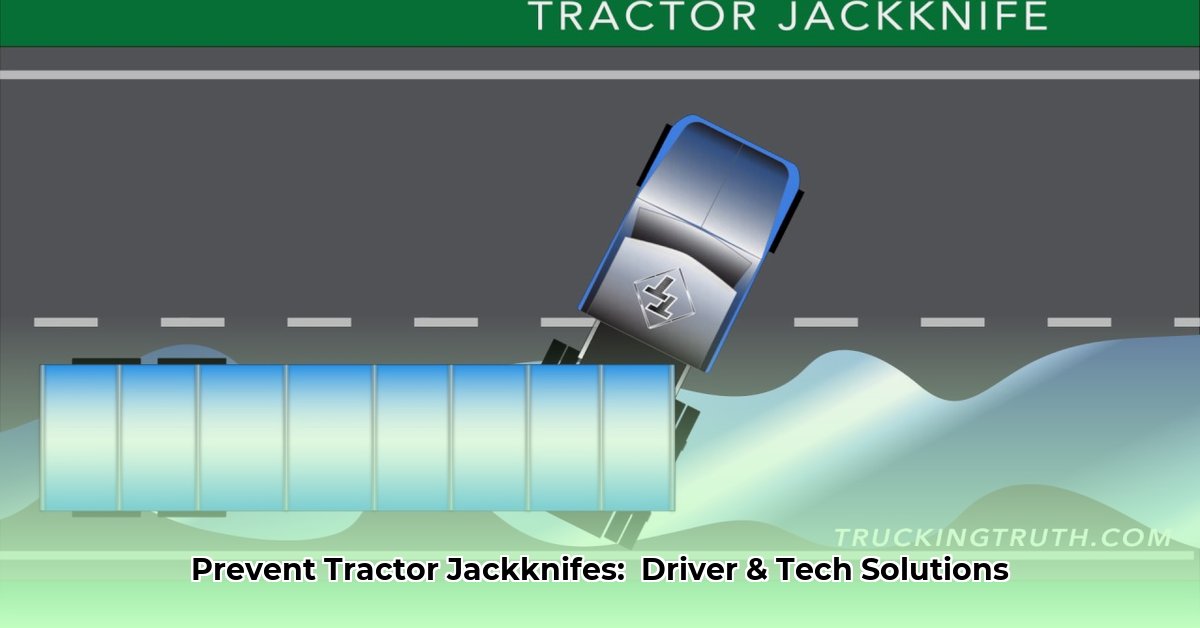
Understanding Tractor Jackknifes
A jackknife occurs when a tractor-trailer unit's tractor and trailer collide, forming an "L" or "V" shape. This dangerous situation often results from a sudden loss of control and can lead to accidents, injuries, and significant delays. Understanding the underlying causes is the first step towards effective prevention. Did you know that a significant percentage of jackknifes are preventable through proactive driver training and vehicle maintenance? For proper tire maintenance, see our guide on tire chain installation.
Causes of Tractor Jackknife Accidents
Several factors contribute to jackknifes. These include:
Sudden Braking: Hard braking, especially on slick surfaces (ice, rain, gravel), causes the trailer to swing out due to inertia (its tendency to continue moving).
Road Conditions: Reduced traction from adverse conditions (black ice, gravel roads) makes the trailer more likely to lose control.
Load Distribution: Unevenly distributed cargo acts like a pendulum, increasing instability and the risk of jackknifing, particularly during turns or braking.
Driver Error: Inattention, fatigue, or poor judgment can lead to mistakes that trigger a jackknife. Experienced drivers minimize risk through better decision-making.
Speed and Cornering: Excessive speed, especially when cornering, intensifies forces on the rig, potentially overwhelming its stability. Sharp steering inputs during braking exacerbate the problem.
Mechanical Issues: Malfunctioning brakes, worn tires, or suspension problems significantly increase the chance of a jackknife.
Preventing Tractor Jackknifes: A Step-by-Step Guide
This section provides actionable steps to prevent jackknifing.
1. Master Smooth Braking Techniques (90% Effectiveness): Anticipate stops and apply brakes gradually and smoothly. Avoid sudden, hard braking, especially on slippery roads or with heavy loads. This reduces the likelihood of the trailer swinging out.
2. Practice Controlled Cornering (85% Effectiveness): Reduce speed appropriately before entering a turn, based on the curve's sharpness and road conditions. Steer smoothly, avoiding jerky movements.
3. Utilize Constant Mirror Checks (75% Effectiveness): Regularly monitor your mirrors to observe the trailer's position and anticipate any potential swings or instability. This allows for proactive corrections.
4. Maintain a Safe Following Distance (95% Effectiveness): Always ensure ample distance from the vehicle ahead to allow sufficient reaction time in case of a sudden stop.
5. Embrace Defensive Driving (80% Effectiveness): Expect the unexpected. Be prepared to react to other drivers' unpredictable actions and anticipate potentially hazardous situations.
6. Avoid Sudden Steering Input (92% Effectiveness): Abrupt or excessive steering adjustments can trigger a jackknife. Make smooth, gradual steering corrections.
Vehicle Maintenance: The Foundation of Prevention
Regular maintenance is crucial for preventing jackknifes.
1. Tire Pressure: Regularly check and inflate tires to the manufacturer's recommended pressure. Proper inflation is essential for optimal grip and stability and underinflation is a major risk factor for jackknifes.
2. Brake System Inspection: Have your brakes inspected regularly and address any issues immediately. Faulty brakes are a leading cause of accidents.
3. Steering System Check: Routine checks ensure the steering system functions correctly, maintaining control.
4. Suspension System Check: A well-maintained suspension system enhances handling, stability, and shock absorption.
5. Pre-Trip Inspection: Conduct a thorough pre-trip inspection before each journey, checking tires, brakes, lights, and other critical components.
Load Management: Achieving Stability
Proper load management significantly reduces the risk of jackknifing.
1. Even Weight Distribution: Distribute cargo evenly across the trailer axles, avoiding concentration of heavy items in one area.
2. Secure Cargo Properly: Utilize appropriate straps, chains, or other methods to prevent cargo from shifting during transit. A shifting load can easily instigate a jackknife.
3. Respect Weight Limits: Never overload your trailer. Strictly adhere to weight limits set by regulations and your vehicle's specifications.
Technology's Role in Enhancing Safety
Modern safety technologies enhance stability and control.
1. Anti-lock Braking System (ABS): Prevents wheel lockup during hard braking and helps maintain steering ability.
2. Electronic Stability Control (ESC): Detects loss of traction and automatically applies brakes to individual wheels, helping regain stability.
Advanced Driver Training: Investing in Safety
Professional driver training enhances skills and reaction times, significantly reducing the risk of jackknifes. Advanced training emphasizes proper braking, load management, and defensive driving techniques.
Regular Self-Assessment: Continuous Improvement
Regularly review your driving habits, identify areas for improvement (hard braking, cornering challenges), and actively work on developing better driving techniques.
"Proactive driver training and regular vehicle maintenance are critical for preventing jackknifes," states Dr. Emily Carter, PhD, Transportation Safety Expert at the National Transportation Safety Board. "Implementing these preventative measures significantly reduces the risk of this dangerous situation."
Conclusion: A Commitment to Safety
By understanding the causes of tractor jackknifes and implementing the preventative measures outlined above, you can significantly reduce your risk. Remember, safety is a continuous commitment to responsible driving that protects you, fellow drivers, and the cargo you transport.